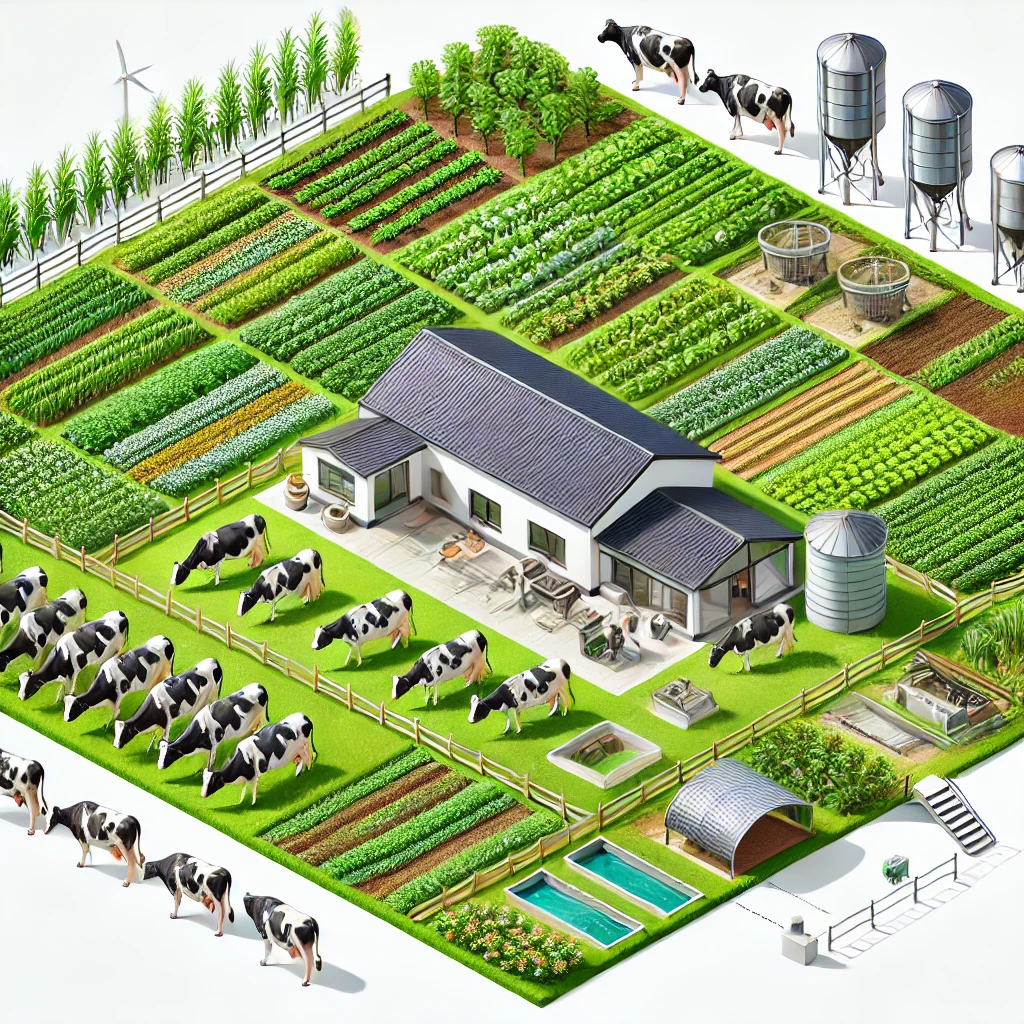Managing fodder for a dairy farm on one acre for year-round supply takes careful planning, but it’s definitely possible! Let’s break it down step by step:
Drip irrigation: Saves water and boosts fodder production.
Estimate Fodder Requirements:
Suppose you have 5–10 cows. A cow generally needs 25–30 kg of green fodder, 6–8 kg of dry fodder, and 3–4 kg of concentrate feed daily.
For 10 cows, you’d need around 300 kg of green fodder daily → ~9,000 kg per month → ~1,08,000 kg yearly.
Choose High-Yielding Fodder Crops:
Green Fodder: Hybrid Napier (CO-4, CO-5), Maize, Sorghum, Berseem, Ryegrass.
Dry Fodder: Bajra, Sorghum, Paddy Straw, Wheat Straw.
Protein-Rich Legumes: Lucerne, Cowpea, Stylo, Hedge Lucerne.
Crop Planning (Fodder Calendar):
Kharif Season (June–Oct): Maize, Hybrid Napier, Cowpea (Fast-growing, high yield).
Rabi Season (Nov–Feb): Berseem, Ryegrass, Oats (Winter greens, good protein).
Summer Season (March–May): Sorghum, Bajra, Lucerne (Heat-tolerant, high yield).
Intercropping & Rotation:
Combine legumes (like cowpea) with cereals (like maize) to improve soil fertility and provide balanced nutrition.
Perennial Fodder:
Grow crops like Hybrid Napier, Lucerne, or Guinea Grass — once planted, they keep producing for 3–5 years.
Silage & Haymaking (Storage for Off-Season):
Silage: Ferment maize, sorghum, or Napier in pits for green fodder storage.
Hay: Sun-dry excess green fodder like lucerne, oats, or berseem.
Space Management:
0.5 acre: Perennial fodder (Hybrid Napier, Lucerne) — for regular supply.
0.25 acre: Seasonal green crops (Maize, Sorghum, Cowpea) — fast-growing.
0.15 acre: Dry fodder crops (Bajra, Wheat) — for straw collection.
0.10 acre: Silage preparation area & storage.
Soil & Water Management:
Fertilize naturally: Use cow dung, compost, and green manure.
Starting a dairy farm
Starting a dairy farm on just one acre of land is both ambitious and feasible, provided you plan efficiently and manage resources well. Dairy farming is not only a profitable venture but also contributes significantly to food production. This guide will walk you through the step-by-step process of starting and managing a dairy farm on one acre, covering land use, cattle selection, infrastructure, feeding, health care, and marketing.
1. Planning and Preparation
1.1 Assessing the Land and Climate
- Ensure the land is fertile and well-drained.
- Access to clean water is essential.
- Consider the local climate and its impact on cattle health and milk production.
1.2 Budgeting and Investment
- Estimate initial investment for cattle, infrastructure, and equipment.
- Plan for recurring costs like feed, veterinary care, and labor.
- Explore funding options like agricultural loans and government subsidies.
2. Choosing the Right Breed
- Select high-yielding, disease-resistant breeds like Holstein, Jersey, or local indigenous breeds suitable for your climate.
- Consider breeds known for their milk quality and adaptability.
3. Infrastructure Development
3.1 Housing and Shelter
- Construct a well-ventilated, spacious shed with proper drainage.
- Ensure adequate space per animal (approximately 40-50 sq ft per cow).
- Provide separate areas for milking, feeding, and resting.
3.2 Feeding and Storage Facilities
- Set up feed storage to keep hay, silage, and grains dry and safe.
- Install water troughs and feeding stations.
3.3 Waste Management
- Develop a manure management system for composting or biogas production.
- Keep the environment clean to prevent disease.
4. Cattle Procurement
- Purchase healthy, vaccinated cows from reputable breeders.
- Check veterinary records and physical health.
- Prefer cows in early lactation for immediate milk production.
5. Feeding and Nutrition
- Provide a balanced diet with green fodder, dry fodder, and concentrates.
- Supplement with minerals and vitamins.
- Ensure access to clean drinking water at all times.
6. Health Care and Disease Management
- Schedule regular veterinary check-ups and vaccinations.
- Maintain hygiene in the shed and feeding areas.
- Keep records of health, breeding, and milk production.
7. Milking and Milk Handling
- Use hygienic milking practices to prevent contamination.
- Consider investing in a small milking machine for efficiency.
- Store milk in clean, cool containers to maintain quality.
8. Marketing and Sales
- Identify your target market: local households, dairy cooperatives, or processing units.
- Explore value-added products like curd, butter, and cheese.
- Use digital marketing and local networks to expand your customer base.
9. Financial Management and Record Keeping
- Track income and expenses meticulously.
- Maintain records of milk production, sales, and veterinary care.
- Analyze profitability and plan for future growth.
10. Expansion and Diversification
- Consider integrating other ventures like poultry, goat farming, or vegetable cultivation.
- Explore organic milk production for premium pricing.
- Invest in training and technology for improved efficiency.
Conclusion
Starting a dairy farm on one acre requires strategic planning, careful investment, and dedicated management. With the right approach, you can create a sustainable and profitable dairy business, contributing to your financial growth and the agricultural ecosystem.
